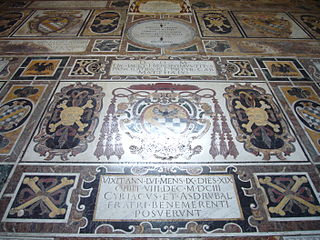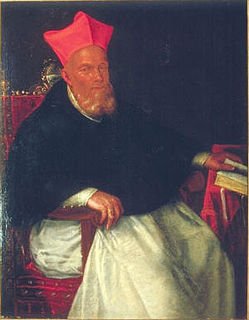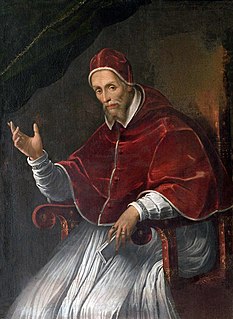A doctor of both laws, from the Latin doctor utriusque juris, or juris utriusque doctor, or doctor juris utriusque is a scholar who has acquired a doctorate in both civil and church law. The degree was common among Roman Catholic and German scholars of the Middle Ages and early modern times. Today the degree is awarded by the Pontifical Lateran University after a period of six years of study, by the University of Würzburg, and by the University of Fribourg, as well as the University of Cologne.

Santa Maria dei Miracoli and Santa Maria di Montesanto are two churches in Rome.

The Palazzo Mattei di Giove is the most prominent among a group of Mattei houses that forms the insula Mattei in Rome, Italy, a block of buildings of many epochs.

The House of Mattei was one of the most powerful noble families of Rome during the Middle Ages and early modern era, holding high positions in the papal curia and government office. The family amassed significant art collections under art enthusiasts such as Ciriaco Mattei.

The basilica of San Pancrazio is a Roman Catholic ancient basilica and titular church founded by Pope Symmachus in the 6th century in Rome, Italy. It stands in via S. Pancrazio, westward beyond the Porta San Pancrazio that opens in a stretch of the Aurelian Wall on the Janiculum. It covers the Catacomb of San Pancrazio.

The Diocese of Frascati is a suburbicarian see of the Holy Roman Church and a diocese of the Catholic Church in Italy, based at Frascati, near Rome. The bishop of Frascati is a Cardinal Bishop; from the Latin name of the area, the bishop has also been called Bishop of Tusculum. Tusculum was destroyed in 1191. The bishopric moved from Tusculum to Frascati, a nearby town which is first mentioned in the pontificate of Pope Leo IV. Until 1962, the Cardinal-Bishop was concurrently the diocesan bishop of the see in addition to any curial duties he possessed. Pope John XXIII removed the Cardinal Bishops from any actual responsibility in their suburbicarian dioceses, and made the title purely honorific.

A crown-cardinal was a cardinal protector of a Roman Catholic nation, nominated or funded by a Catholic monarch to serve as their representative within the College of Cardinals and, on occasion, to exercise the right claimed by some monarchs to veto a candidate for election to the papacy. More generally, the term may refer to any cardinal significant as a secular statesman or elevated at the request of a monarch.
Ciriaco Mattei was an Italian nobleman of Rome and of the House of Mattei and one of the most prolific art collectors of his time.

Girolamo Mattei was an Italian Cardinal from the House of Mattei.

Ruggero Luigi Emidio Antici Mattei was an Italian Cardinal of the Roman Catholic Church. He served as Latin Patriarch of Constantinople from 1866 to 1875, and was elevated to the cardinalate by Pope Pius IX in 1875.

The Fontana delle Tartarughe is a fountain of the late Italian Renaissance, located in Piazza Mattei, in the Sant'Angelo district of Rome, Italy. It was built between 1580 and 1588 by the architect Giacomo della Porta and the sculptor Taddeo Landini. The bronze turtles around the upper basin, usually attributed either to Gian Lorenzo Bernini or Andrea Sacchi, were added in either 1658 or 1659 when the fountain was restored.

Girolamo Cardinal Bernerio, O.P. was an Italian Cardinal of the Roman Catholic Church.

Fabrizio Spada was an Italian Cardinal of the Roman Catholic Church, and served as Secretary of State under Pope Innocent XII.

The September 1590 papal conclave elected Cardinal Giovanni Battista Castagna as Pope Urban VII.

Luigi Mattei was an Italian military General and Marquis de Belmonte. During the 17th century he commanded troops loyal to the papal armies of Barberini Pope Urban VIII and Pamphili Pope Innocent X during the Wars of Castro.
Girolamo Mattei was an Italian nobleman of the House of Mattei and Duke of Giove.

Asdrubale Mattei, Duca di Giove, was an Italian nobleman of the House of Mattei, an avid art collector and a patron of Caravaggio.

Vincenzo Maria Altieri (1724–1800) was an Italian Roman Catholic cardinal from 1777 to 1800. He belonged to the Altieri family, one of the noble families of Rome.
Mattei is a surname. Notable people with the surname include:














